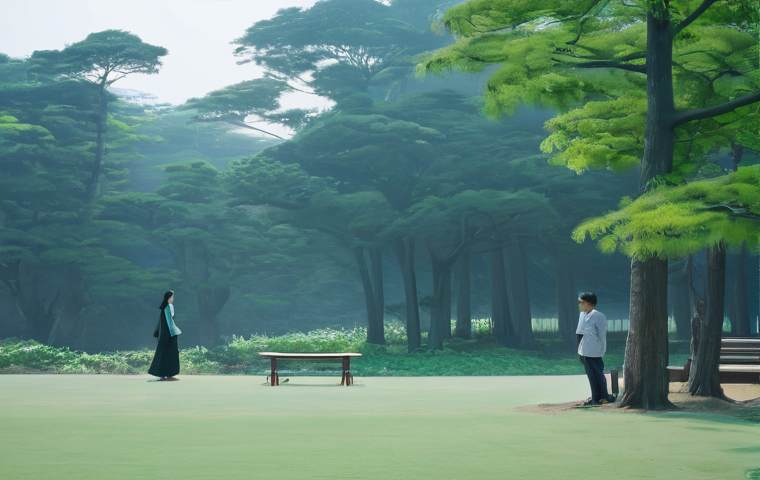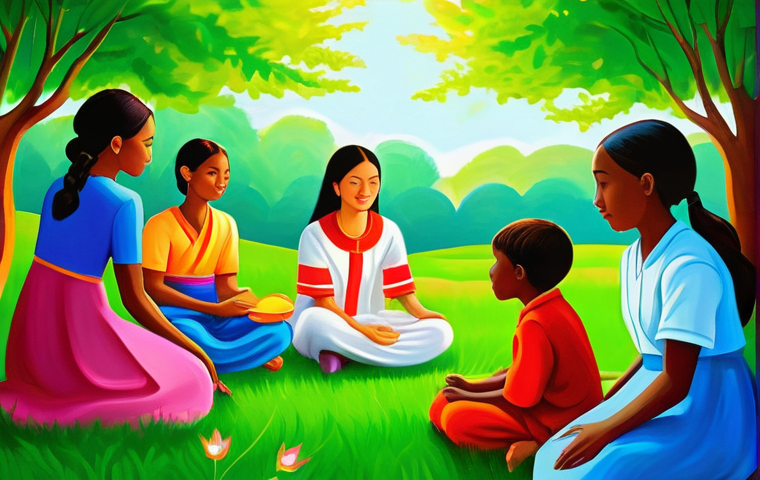Ever felt like the world just needs a reset button, a way to truly resolve all the lingering issues and usher in genuine harmony? I know I have! Diving into different spiritual paths, I’ve discovered something truly profound from Korea: Daesoon Jinrihoe.
It’s a fascinating new religion that isn’t just about personal enlightenment, but about actively reordering the universe to create an “Earthly Paradise” right here and now.
Their core principle, “Haewon Sangsaeng” – the resolution of grievances for mutual beneficence – really resonated with me, offering a powerful vision for a world free from conflict.
It’s a blend of ancient wisdom and a forward-thinking approach that seeks to unite heaven, earth, and humanity. Let’s unpack this incredible philosophy together and see what makes it so unique!
Unpacking “Haewon Sangsaeng”: More Than Just Forgiveness

You know that heavy feeling you get when someone’s wronged you, or when you just feel stuck in a cycle of misunderstanding? I’ve definitely been there, and it’s absolutely draining. When I first encountered the concept of “Haewon Sangsaeng” from Daesoon Jinrihoe, it wasn’t just another spiritual platitude; it genuinely felt like a lightbulb moment. It translates roughly to “the resolution of grievances for mutual beneficence,” but honestly, that doesn’t quite capture the depth of it. It’s about acknowledging that unresolved resentments, not just between people but even from past generations and between spiritual beings, create this energetic knot in the universe. Imagine carrying around a backpack full of old grudges – this principle is like systematically emptying that bag, not just for your own peace, but for everyone involved. It’s a radical idea because it suggests that our current suffering isn’t just random, but a culmination of these historical grievances that need to be actively untangled. For me, it shifted my perspective from just forgiving someone to actively seeking a way for everyone to benefit, to genuinely move forward in a way that truly heals the past.
Beyond Simple Apologies: A Deeper Healing
When we talk about resolving grievances, it’s not simply saying “I’m sorry” and moving on, though that’s a good start, of course. My understanding, based on exploring this teaching, is that it’s about a profound recognition of the suffering caused and a conscious effort to restore harmony in a way that benefits all parties involved. It addresses the idea that unfair treatment in the past creates lingering resentment, and until that resentment is truly addressed and dissolved, true progress is halted. It’s like cleaning a wound properly – you don’t just put a band-aid on it; you clean it thoroughly so it can actually heal from the inside out. This principle really resonated with my own experiences, making me realize how much unspoken or unaddressed hurt can fester, impacting not just individuals but entire communities. The idea that these grievances aren’t just personal but extend into the spiritual realm and across generations truly blew me away, giving a whole new dimension to responsibility and compassion.
Mutual Beneficence: A Win-Win for the Universe
The “mutual beneficence” part of Haewon Sangsaeng is what makes it so incredibly powerful. It’s not about one side winning and the other losing; it’s about finding a path where everyone, literally everyone – humans, spirits, and even nature itself – benefits. My personal take on this is that it encourages us to look for solutions that uplift everyone, rather than just our immediate circle or our own self-interest. Think about it: how many conflicts in the world could be resolved if we genuinely sought outcomes where all parties felt heard, respected, and even benefited? This isn’t just an abstract concept; I’ve seen how even small acts of genuine understanding and compromise in my own life can ripple outwards, creating a more positive environment. Daesoon Jinrihoe teaches that this principle is the foundation for global peace and harmony, a truly transformed world. It’s an ambitious vision, but one that, to me, makes perfect sense when you consider the interconnectedness of everything.
The Grand Vision: Crafting an Earthly Paradise Together
The concept of an “Earthly Paradise” sounds almost too good to be true, doesn’t it? When I first heard it, I immediately thought of some distant, ethereal heaven. But what truly sets Daesoon Jinrihoe apart, in my opinion, is their unwavering belief that this paradise isn’t some far-off reward after death, but something we actively build right here, right now. It’s not just about waiting for a divine intervention; it’s about a collaborative effort between the divine and humanity to transform our current reality. This really clicked with me because it puts the power back in our hands, emphasizing our role in making the world a better place. It’s a vision that inspires action, encouraging us to look at our daily lives and consider how our choices contribute to or detract from this grand project. The “Reordering Works of the Universe,” or Chunji-gongsa as they call it, isn’t just ancient history; it’s a continuous process where we, as humans, are now integral participants, called to manifest this ideal world through our own efforts. It transforms the spiritual journey into a very tangible, earth-bound mission, which I find incredibly motivating.
A World Reborn: Beyond Conflict and Disease
What would an Earthly Paradise actually look like? Well, from what I’ve learned, it’s a world fundamentally free from the old cycles of conflict, injustice, and even disease. Imagine that for a moment: a society where mutual respect and cooperation are the norm, where the very air we breathe feels cleansed of historical grievances. It’s a powerful image, and I can almost feel the weight lift just thinking about it. Daesoon Jinrihoe believes that through the complete resolution of grievances, a profound “Great Transformation” (Gaebyeok) will occur, ushering in this Later World (Hucheon) of unprecedented peace and prosperity. It’s not just about a lack of negative things, but an abundance of positive ones – good health, long life, and genuine happiness for everyone. It’s a radical departure from the fatalistic views I’ve sometimes encountered, offering a vibrant, hopeful alternative that we are all empowered to contribute to. This promise of a tangible, immediate paradise on Earth is definitely one of the most compelling aspects of their teachings.
Our Role in the Divine Blueprint
What’s really fascinating is that this Earthly Paradise isn’t just granted to us; it’s something we co-create. Daesoon Jinrihoe emphasizes that while the Supreme God, Kang Jeungsan, initiated the reordering, human beings have a crucial part to play in bringing it to full fruition. This is where personal cultivation and social engagement become so important. My personal understanding is that it’s like a grand construction project where the divine provides the blueprint and the initial resources, but we, the human architects and builders, are responsible for laying the bricks and shaping the structure. It means cultivating virtues like honesty, truthfulness, and impartiality, discarding selfishness, and actively working towards the betterment of others. It’s a refreshing take on spirituality, moving beyond passive worship to active participation in the divine plan. This active engagement gives me a sense of purpose, knowing that my everyday actions, however small, can contribute to something truly monumental.
Beyond Words: How Action Shapes Our Shared Future
It’s one thing to talk about grand philosophies, but it’s another entirely to put them into practice. What really impressed me about Daesoon Jinrihoe is their commitment to action, transforming their spiritual ideals into tangible benefits for society. They don’t just preach; they *do*. My exploration into their activities revealed a robust framework of social engagement that genuinely makes a difference in people’s lives. They organize their practical efforts around what they call the “Three Major Works”: charity aid, social welfare, and education. For me, this is where the rubber meets the road. It shows a profound understanding that spiritual enlightenment isn’t just an internal journey, but one that must manifest in outward acts of compassion and service. It’s not enough to simply *believe* in mutual beneficence; you have to *live* it. This commitment to practical application deeply resonated with my personal values, highlighting how faith can be a powerful engine for positive social change.
Healing Communities Through Charity and Welfare
I’ve personally seen the impact that dedicated charity and social welfare can have, and Daesoon Jinrihoe really exemplifies this. Their efforts aren’t just token gestures; they run hospitals, welfare foundations for the elderly, and other social programs. Imagine living in a community where a significant portion of a religious movement’s resources—they even state that 70% of their raised funds go to these activities—are dedicated to helping those in need! This isn’t just about handouts; it’s about building sustainable systems of care and support. My experience has shown me that true compassion involves systemic change, not just individual acts of kindness. This movement’s dedication to providing tangible relief and support, especially in areas like medical service and elder care, really stands out. It demonstrates a holistic approach to well-being, recognizing that an “Earthly Paradise” needs a strong foundation of social justice and care for all its members, particularly the most vulnerable.
Empowering Minds Through Education
Education is another pillar of Daesoon Jinrihoe’s practical application, and it’s something I believe is absolutely vital for any progressive movement. They’ve established educational facilities, including Daejin University and several high schools, which is quite an undertaking for any organization. This commitment to education really speaks to the long-term vision of the movement. It’s not just about addressing immediate needs but empowering individuals with knowledge and skills for the future, fostering the kind of enlightened citizens who can truly contribute to an Earthly Paradise. For me, education is the ultimate form of empowerment, and seeing a spiritual movement prioritize it so highly is truly inspiring. It reflects the understanding that a transformed world requires transformed minds – minds capable of critical thought, compassion, and innovation. It’s a proactive approach to cultivating the human spirit and developing the expertise needed to navigate and solve the complex challenges of our world.
A Journey Through Time: Tracing Daesoon Jinrihoe’s Roots
Every significant movement has a story, a lineage that gives it depth and context, and Daesoon Jinrihoe is no different. Diving into its history, I found myself captivated by the narrative of its origins, which feels deeply rooted in Korean spiritual tradition yet strikingly forward-thinking. It’s not an ancient religion in the same vein as Buddhism or Confucianism, but rather a “new religious movement” that emerged from a profound period of change in Korea. The story begins with Kang Jeungsan, who followers believe was the Supreme God (Gucheon Sangje) incarnated on Earth at the end of the 19th century. My understanding is that he undertook what they call the “Reordering Works of the Heaven and Earth” (Chunji-gongsa) to rectify the chaotic state of the world, laying the groundwork for the Earthly Paradise. This isn’t just a dry historical account; it’s a living narrative that shapes the beliefs and practices of its followers today, giving them a sense of divine purpose and a connection to a profound spiritual lineage. It truly shows how powerful a compelling origin story can be in galvanizing a community.
The Path Unfolds: From Kang Jeungsan to Park Wudang
The lineage of Daesoon Jinrihoe is particularly interesting because it emphasizes a direct succession of religious orthodoxy. After Kang Jeungsan’s passing in 1909, his teachings and mission were carried forward. My research shows that the Lord of the Dao, Jo Jeongsan, was the one who received the revelation and truly systematized the teachings, establishing an earlier religious order. Then, crucially, the Leader of Principle, Park Wudang, inherited this mandate and formally founded Daesoon Jinrihoe in 1969. This progression, from the divine incarnation to the systematizer to the organizational founder, really paints a picture of a carefully planned spiritual evolution. It highlights how important leadership and clear transmission of teachings are for any movement to thrive and grow. It’s not just about one charismatic figure, but a continuity of vision and effort across generations, ensuring the core message remains intact while adapting to the needs of the time. This multi-generational leadership, in my opinion, lends significant credibility and stability to the movement.
The Sacred Texts: Guiding the Way

Just like any major spiritual tradition, Daesoon Jinrihoe has its canonical scripture, primarily the *Jeon-gyeong*. This text, from what I’ve learned, serves as the cornerstone of their doctrine, meticulously recording Kang Jeungsan’s life, teachings, and the profound Reordering Works he undertook. It’s not just a historical document; it’s a living guide for adherents, outlining the tenets, creeds, and objectives that define their spiritual path. I find it fascinating how such texts encapsulate centuries of wisdom and provide a framework for understanding the universe and our place within it. For someone like me, who loves diving into foundational texts, the *Jeon-gyeong* offers a rich tapestry of spiritual insight, explaining how the principles of Haewon Sangsaeng, the Earthly Paradise, and cultivation are all interconnected. It’s a testament to the depth of their thought that these ancient insights are still so relevant for contemporary spiritual seekers.
Finding Inner Peace: Cultivation in Daily Life
When I think about spirituality, I often gravitate towards practices that bring a sense of inner calm and purpose. Daesoon Jinrihoe’s approach to cultivation, or *gongbu*, really emphasizes this internal transformation as a prerequisite for external change. It’s not just about attending ceremonies; it’s about a deeply personal and continuous effort to refine one’s character and align with the divine truth. My personal experience with various forms of self-improvement tells me that consistent, mindful effort is key, and Daesoon Jinrihoe’s cultivation methods seem designed to foster just that. It’s a comprehensive path that involves moral practice, reverence for Sangje (the Supreme God), and specific rituals that are believed to hasten the advent of the Earthly Paradise. For me, it’s a powerful reminder that while we work to change the world around us, the most profound changes often begin within ourselves. It’s about becoming the change we wish to see, embodying the principles we advocate for.
The Practice of Moral Virtues: Living with Integrity
At the heart of Daesoon Jinrihoe’s cultivation is the unwavering commitment to moral virtues. It’s not enough to intellectually grasp concepts like “Haewon Sangsaeng”; one must actively embody them in daily interactions. This means cultivating honesty, truthfulness, impartiality, and a spirit of mutual understanding, while actively discarding selfishness and self-deception. I’ve often felt that true spiritual growth is reflected more in how we treat others than in any grand pronouncements. This emphasis on practical ethics really resonated with me because it makes spirituality actionable and relevant to everyday life. It’s about building harmonious relationships, starting with our families and extending outwards to society and the entire world. It’s a constant process of self-reflection and adjustment, striving to live in a way that generates benefit rather than grievance, a journey that I believe is universally valuable regardless of one’s specific faith.
Chanting and Offerings: Connecting with the Divine
Beyond moral conduct, Daesoon Jinrihoe also incorporates specific rituals, including incantations and devotional offerings, as part of their cultivation. While I haven’t personally participated in these, my understanding is that they serve as powerful ways to connect with the divine and to focus one’s spiritual energy. The chanting of mantras, for instance, can be a deeply meditative practice, helping to quiet the mind and foster a sense of inner peace and unity. These practices are not just rote repetitions; they are believed to be essential tools for self-transformation and for contributing to the larger Reordering Works. From what I’ve gathered, these rituals are performed at specific times and places, creating a disciplined rhythm for spiritual life. It’s a beautiful illustration of how structured practices can complement personal ethical living, providing a holistic path for those seeking deeper spiritual connection and involvement in the larger cosmic plan.
A Uniquely Korean Path to Universal Harmony
What I find truly fascinating about Daesoon Jinrihoe is its ability to weave together ancient Korean spiritual traditions with a modern, universal message. It’s been described as the “quintessential Korean religion” by scholars, and after delving into its principles, I totally get why. It seamlessly integrates elements from Confucianism, Buddhism, Daoism, and even indigenous Korean shamanism, but it’s more than just a blend; it has its own distinct, innovative voice. This syncretic approach, to me, is incredibly appealing. It shows a wisdom that doesn’t seek to discard existing truths but rather to find the underlying harmony between them. My experience has taught me that different paths often lead to similar truths, and Daesoon Jinrihoe seems to embody this understanding. It offers a fresh perspective that respects its historical roots while actively addressing the complex challenges of the contemporary world, aiming for a harmony that transcends cultural and religious boundaries.
Beyond Traditional Boundaries: A New Synthesis
One of the most striking aspects of Daesoon Jinrihoe, for me, is how it diverges from purely Western theological models, yet still offers universal appeal. Unlike some traditions that focus solely on the afterlife, this movement firmly plants its paradise on Earth. It also empowers humans to become “god-like” through their own efforts, a concept that aligns more with traditional East Asian anthropocentrism than Western theocentrism. It doesn’t rely on traditional Sunday services with hymns and sermons, which makes it distinct even among other new religious movements. My personal observation is that this unique synthesis creates a spiritual space that feels both ancient and cutting-edge, offering a fresh lens through which to view human potential and the future of our world. It’s a testament to the richness of Korean spiritual heritage, presented in a way that feels relevant and compelling to a global audience today, promising a new world free of the old conflicts.
The Universal Invitation: A Path for All
Despite its deep Korean roots and distinct features, the message of Daesoon Jinrihoe, particularly its emphasis on “Haewon Sangsaeng” and the Earthly Paradise, truly speaks to universal human aspirations for peace, justice, and well-being. It’s an invitation to everyone, regardless of background, to participate in the grand project of reordering the universe. I’ve always believed that true wisdom is universally applicable, and this movement’s dedication to social welfare, education, and charity reflects a profound commitment to the betterment of all humanity. It’s not an exclusive club; it’s a call to action for anyone who dreams of a world free from suffering and filled with mutual beneficence. This universal appeal, combined with its strong ethical foundation and practical social engagement, makes it a truly compelling spiritual path for anyone looking to contribute to a more harmonious and just world. It’s about building a better future, together, right here on our shared home.
| Principle | Meaning & Significance |
|---|---|
| Haewon Sangsaeng | Resolution of grievances for mutual beneficence; a core idea to dissolve accumulated resentments from the past and present across all realms for collective healing and harmony. |
| Sinin Johwa | Harmonious union between divine beings and human beings; recognizing the interconnectedness and cooperative relationship between spirits and humanity. |
| Eumyang Hapdeok | Virtuous concordance of Yin and Yang; emphasizing balance and harmony of opposing forces as fundamental to the universe and human interaction. |
| Dotong Jin’gyeong | Perfected unification with Dao; the ultimate goal of achieving earthly immortality and absolute spiritual enlightenment, realizing the Earthly Paradise. |
Wrapping Up
Wow, what a journey it’s been delving into the profound world of Daesoon Jinrihoe! I genuinely hope my exploration has given you a fresh perspective on this unique spiritual path.
For me, personally, understanding “Haewon Sangsaeng” and the vision of an “Earthly Paradise” has been incredibly inspiring. It’s not just a set of beliefs; it’s a call to action, reminding us that we each have a role to play in healing past grievances and building a more harmonious future, right here, right now.
It truly feels like a blueprint for a world we all long to live in, one where peace isn’t just a dream, but a tangible goal we can achieve together, one conscious action at a time.
It’s about leaving behind a legacy of beneficence, not just for ourselves, but for generations to come.
Good-to-Know Information
1. Daesoon Jinrihoe is a relatively modern Korean religious movement that beautifully intertwines elements of Confucianism, Buddhism, Daoism, and indigenous Korean spiritual traditions into a unique, comprehensive doctrine. It’s truly a rich tapestry of thought.
2. At its very heart lies the concept of Haewon Sangsaeng, which translates to “the resolution of grievances for mutual beneficence.” This isn’t just about forgiveness; it’s a radical idea that seeks to untangle historical and spiritual resentments for the benefit of all, leading to genuine collective healing.
3. A core objective of the faith is the realization of an “Earthly Paradise,” a transformed world free from conflict, injustice, and disease, brought about through the collaborative efforts of divine beings and humanity. It’s a wonderfully hopeful vision for our shared future.
4. The movement is remarkably action-oriented, committing significant resources to social welfare through its “Three Major Works”: charity aid, social welfare, and education. They truly walk the talk, establishing hospitals, welfare foundations, and even universities.
5. Daesoon Jinrihoe traces its origins to Kang Jeungsan, who followers believe was the Supreme God incarnated on Earth, initiating the “Reordering Works of the Universe,” with the teachings being systematically organized and transmitted through a clear succession of spiritual leaders.
Key Takeaways
What truly sticks with me after exploring Daesoon Jinrihoe is its powerful message of human agency in creating a better world. It’s not about passively waiting for change, but actively participating in a grand cosmic reordering, driven by principles like mutual beneficence and personal cultivation.
This blend of profound spiritual insights with tangible social action offers a compelling path for anyone seeking to contribute to global harmony and personal growth.
It reminds us that every act of compassion and every effort to resolve grievances, however small, ripples outwards, shaping our shared future into the Earthly Paradise we all deserve.
Frequently Asked Questions (FAQ) 📖
Q: So, what exactly is Daesoon Jinrihoe? It sounds fascinating, but can you give me the lowdown?
A: Oh, I totally get why you’re curious! When I first stumbled upon Daesoon Jinrihoe, I felt the same way – it just resonated with something deep inside.
At its heart, Daesoon Jinrihoe is a vibrant new religion from Korea that believes in the Supreme God, Gucheon Sangje, who, according to their teachings, actually incarnated here on Earth as Kang Jeungsan in the late 19th century.
Think about that for a second: the highest celestial deity coming down to walk among us! The core idea is that the world had fallen into such a state of chaos and grievance – what they call the “Former World” – that Sangje descended to carry out His “Reordering Works of Heaven and Earth,” a kind of cosmic renovation project.
The ultimate goal? To clear away all the accumulated negativity and suffering to usher in a brand-new era: an “Earthly Paradise.” It’s not about waiting for heaven in the afterlife; it’s about actively building a harmonious, conflict-free world right here, right now.
It really shifted my perspective on what spiritual practice could achieve, moving beyond just personal enlightenment to universal transformation.
Q: That “Earthly Paradise” sounds incredible! But how does “Haewon Sangsaeng” fit into all of that? What does it actually mean, and how does it help create this paradise?
A: This is where it gets really powerful, and honestly, it’s the concept that genuinely blew me away. “Haewon Sangsaeng” is usually translated as “the resolution of grievances for mutual beneficence.” If you think about it, so much of our world’s problems stem from grudges, resentments, and unresolved conflicts, right?
Daesoon Jinrihoe teaches that these grievances aren’t just human-to-human; they’ve accumulated across all three realms – Heaven, Earth, and Humanity – for ages.
Sangje’s “Reordering Works” essentially opened up a pathway to start dissolving these ancient, deep-seated grievances. But here’s the kicker: we humans have a crucial role to play!
It’s not a passive waiting game. We actively participate by cultivating moral virtues, spreading truth, and consciously avoiding the creation of new grievances.
It’s like a daily commitment to kindness, understanding, and reconciliation. When we truly practice “Haewon Sangsaeng,” promoting the well-being of others and letting go of our own resentments, we contribute to clearing that cosmic slate.
The vision is that once these layers of negativity are peeled back, we can step into that “Earthly Paradise” – a world free from poverty, sickness, and war, where divine beings and humans live in perfect harmony.
It really feels like a practical roadmap for real, tangible peace.
Q: So, with all these unique ideas, what makes Daesoon Jinrihoe stand out from other religions I might be familiar with?
A: That’s a fantastic question, and one I’ve pondered a lot myself! From my experience exploring different spiritual paths, what immediately struck me about Daesoon Jinrihoe is how deeply it’s woven into Korean traditions.
It beautifully blends elements from Buddhism, Confucianism, Daoism, and even indigenous shamanism, but it’s not just a mix-and-match; it creates something uniquely profound.
Scholars even call it the “quintessential Korean religion.” But beyond its syncretic nature, a major differentiator is its focus on an “Earthly Paradise.” Many faiths promise a divine reward in a heavenly realm after death, but Daesoon Jinrihoe is all about transforming this world, right here, right now, into a harmonious “Later World.” It puts a huge emphasis on human agency and cooperation in bringing about this change.
Plus, I’ve found their practical application of beliefs through extensive social welfare programs – like their hospitals and universities – to be incredibly inspiring.
It’s not just about prayer and meditation; it’s about active engagement in making society better. And unlike some religions that center around a charismatic leader for generations, Daesoon Jinrihoe has evolved to an administrative system, showing a real commitment to its institutional mission rather than being solely dependent on a single figure.
It truly feels like a forward-thinking, grounded approach to spirituality for our modern world.
📚 References
Wikipedia Encyclopedia
구글 검색 결과
구글 검색 결과
구글 검색 결과
구글 검색 결과
구글 검색 결과






